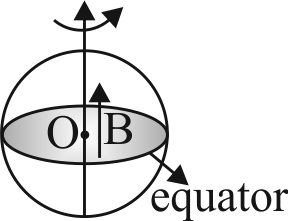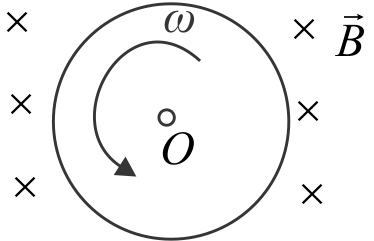358450 A wheel with ten metallic spokes each \(0.50\;\,m\) long is rotated with a speed of \(120\,rev/\min \) in a plane normal to the earth's magnetic field at a place. If the magnitude of the field is 0.4 Gauss, the induced e.m.f., between the axle and the rim of the wheel is equal to
358451 Earth's surface is a conductor with uniform surface charge density \(\sigma\). It rotates about its axis with angular velocity \(\omega\). Suppose the magnetic field due to Sun is \(B\) at the position of Earth and it points along the earth axis. Then the emf developed between the pole and equator of earth due to this field is \(\left(R_{e}=\right.\) radius of earth)
358452 A metal disc of radius \({R}=10 {~cm}\) rotates with a constant angular velocity \(\omega=100\, {rad} / {s}\) about its axis. When the external magnetic field is absent, the potential difference between the centre and rim of the disc is found to be \(2.84 \times 10^{-{x}} {V}\). Find the value of \(x\)
358450 A wheel with ten metallic spokes each \(0.50\;\,m\) long is rotated with a speed of \(120\,rev/\min \) in a plane normal to the earth's magnetic field at a place. If the magnitude of the field is 0.4 Gauss, the induced e.m.f., between the axle and the rim of the wheel is equal to
358451 Earth's surface is a conductor with uniform surface charge density \(\sigma\). It rotates about its axis with angular velocity \(\omega\). Suppose the magnetic field due to Sun is \(B\) at the position of Earth and it points along the earth axis. Then the emf developed between the pole and equator of earth due to this field is \(\left(R_{e}=\right.\) radius of earth)
358452 A metal disc of radius \({R}=10 {~cm}\) rotates with a constant angular velocity \(\omega=100\, {rad} / {s}\) about its axis. When the external magnetic field is absent, the potential difference between the centre and rim of the disc is found to be \(2.84 \times 10^{-{x}} {V}\). Find the value of \(x\)
358450 A wheel with ten metallic spokes each \(0.50\;\,m\) long is rotated with a speed of \(120\,rev/\min \) in a plane normal to the earth's magnetic field at a place. If the magnitude of the field is 0.4 Gauss, the induced e.m.f., between the axle and the rim of the wheel is equal to
358451 Earth's surface is a conductor with uniform surface charge density \(\sigma\). It rotates about its axis with angular velocity \(\omega\). Suppose the magnetic field due to Sun is \(B\) at the position of Earth and it points along the earth axis. Then the emf developed between the pole and equator of earth due to this field is \(\left(R_{e}=\right.\) radius of earth)
358452 A metal disc of radius \({R}=10 {~cm}\) rotates with a constant angular velocity \(\omega=100\, {rad} / {s}\) about its axis. When the external magnetic field is absent, the potential difference between the centre and rim of the disc is found to be \(2.84 \times 10^{-{x}} {V}\). Find the value of \(x\)
358450 A wheel with ten metallic spokes each \(0.50\;\,m\) long is rotated with a speed of \(120\,rev/\min \) in a plane normal to the earth's magnetic field at a place. If the magnitude of the field is 0.4 Gauss, the induced e.m.f., between the axle and the rim of the wheel is equal to
358451 Earth's surface is a conductor with uniform surface charge density \(\sigma\). It rotates about its axis with angular velocity \(\omega\). Suppose the magnetic field due to Sun is \(B\) at the position of Earth and it points along the earth axis. Then the emf developed between the pole and equator of earth due to this field is \(\left(R_{e}=\right.\) radius of earth)
358452 A metal disc of radius \({R}=10 {~cm}\) rotates with a constant angular velocity \(\omega=100\, {rad} / {s}\) about its axis. When the external magnetic field is absent, the potential difference between the centre and rim of the disc is found to be \(2.84 \times 10^{-{x}} {V}\). Find the value of \(x\)


